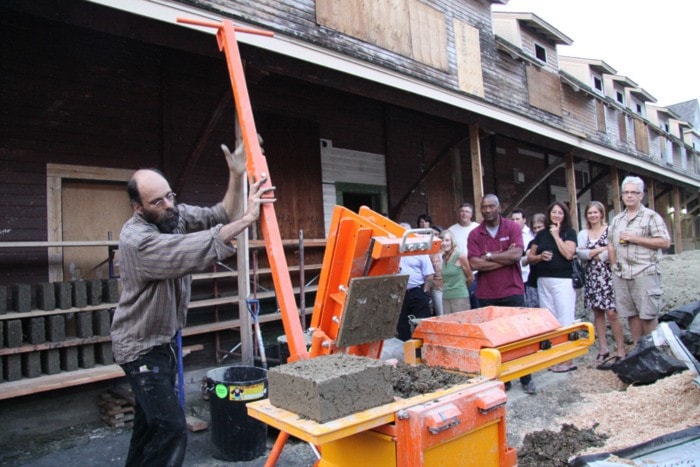Joern Wingender scoops a mixture of clay and wood chips into the mould of his new brick press. He pulls down a leaver to compress the material, then slides the mould away to reveal a finished brick.
"Now I just need to do that 7,000 more times," he laughs, before repeating the process.
The clay bricks air dry on a shelf outside the CP Rail station at the foot of Baker Street. Wingender and his team of four laborers will eventually use them to insulate the old train station.
His team will spend some 50 days or 350 hours making the 7,000 bricks required to line the walls of the 1,100 square foot building. With four people working the press, they can produce about 120 bricks an hour.
It's a laborious process, but Wingender says the result will be worth it.
"I know how well this insulation works when I look at my home heating bill," he says.
He installed the same material in his own home in Procter, and it was also used to insulate the public washroom at Rosemont Park.
Those projects were done before he had the brick press, so the material had to be shaped by hand. Using the press — which he ordered from Southern India — has sped up the process immensely.
"The press makes it commercially viable," he says. "I'd never be able to do a building this size without it."
In the old train station, Wingender will use a process of double thermal insulation, which entails putting in a layer of conventional insulation, then adding a layer of clay bricks and covering the whole thing over with stucco — which can be applied directly to the bricks —to create the interior finish.
Using a single envelope of just clay bricks (as was done at Rosemont Park) would have required 12 inch thick walls cavity and thousands more bricks. While using only conventional insulation would have presented its own difficulties because of the odd angles in the building.
"Doing a conventional finish on a building that's out of shape — leaning, tilting, sagging — it's very expensive because you need a lot of skilled trade labour," Wingender says.
Installing the bricks, by contrast, is unskilled labor. They can easily be moulded to fit whatever idiosyncrasies the building presents.
"With this we can maintain the heritage character of the old buildings that are not perfect, shape-wise."
There are also environmental benefits. The material that goes into making the bricks are all natural, locally-sourced and, in the case of the wood chips, recycled using waste material from other projects.
"There's zero waste and zero fossil-fuels used to produce these bricks," Wingender said. "The only energy consumption is what's fueling my labor — with this crew, that's mostly coffee and smokes."
